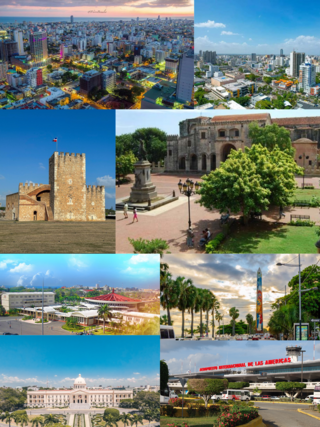
Santo Domingo, once known as Santo Domingo de Guzmán, known as Ciudad Trujillo between 1936 and 1961, is the capital and largest city of the Dominican Republic and the largest metropolitan area in the Caribbean by population. As of 2022, the city and immediate surrounding area had a population of 1,029,110 while the total population is 3,798,699 when including Greater Santo Domingo. The city is coterminous with the boundaries of the Distrito Nacional, itself bordered on three sides by Santo Domingo Province.

Ramón Buenaventura Báez Méndez, was a Dominican conservative politician and military figure. He was president of the Dominican Republic for five nonconsecutive terms. His rule was characterized by corruption and governing for the benefit of his personal fortune.

Juan Pablo Duarte y Díez was a Dominican military leader, writer, activist, and nationalist politician who was the foremost of the founding fathers of the Dominican Republic and bears the title of Father of the Nation. As one of the most celebrated figures in Dominican history, Duarte is considered a folk hero and revolutionary visionary in the modern Dominican Republic, who along with military generals Ramón Matías Mella and Francisco del Rosario Sánchez, organized and promoted La Trinitaria, a secret society that eventually led to the Dominican revolt and independence from Haitian rule in 1844 and the start of the Dominican War of Independence.

Francisco del Rosario Sánchez was a Dominican revolutionary, politician, and former president of the Dominican Republic. He is considered by Dominicans as the second prominent leader of the Dominican War of Independence, after Juan Pablo Duarte and before Matías Ramón Mella. Widely acknowledged as one of the founding fathers of the Dominican Republic, and the only martyr of the three, he is honored as a national hero. In addition, the Order of Merit of Duarte, Sánchez and Mella is named partially in his honor.
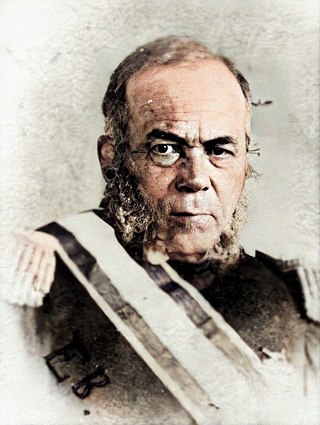
Pedro Santana y Familias, 1st Marquess of Las Carreras was a List of people from the Dominican Republic military commander and royalist politician who served as the president of the junta that had established the First Dominican Republic, a precursor to the position of the President of the Dominican Republic, and as the first President of the republic in the modern line of succession. A traditional royalist who was fond of the Monarchy of Spain and the Spanish Empire, he ruled as a governor-general, but effectively as an authoritarian dictator. During his life he enjoyed the title of "Libertador de la Patria." Aside from Juan Sánchez Ramírez, he was the only other Dominican head of state to serve as a governor to Santo Domingo.

Col. Francisco Alberto Caamaño Deñó was a Dominican soldier and politician who took the constitutional presidency of the Dominican Republic during the Civil War of 1965. During the war, which began on April 24, 1965, Caamaño was one of the leaders in the movement to restore the democratically elected President Dr. Juan Bosch, who had been overthrown in a military coup d'état in September 1963.

The Dominican War of Independence was a war of independence that began when the Dominican Republic declared independence from the Republic of Haiti on February 27, 1844 and ended on January 24, 1856. Before the war, the island of Hispaniola had been united for 22 years when the newly independent nation, previously known as the Captaincy General of Santo Domingo, was unified with the Republic of Haiti in 1822. The criollo class within the country overthrew the Spanish crown in 1821 before unifying with Haiti a year later.

Matías Ramón Mella Castillo, who was most known by his middle name (Ramón), was a Dominican revolutionary, politician, and military general. Mella is regarded as a national hero in the Dominican Republic. He is a hero of two glorious deeds in Dominican history: the proclamation of the First Republic, and the war to restore Dominican independence. Remembered as one of the three founding fathers of the Dominican Republic, the Order of Merit of Duarte, Sánchez and Mella is partially named in his honor.

Ciudad Colonial is the historic central neighborhood of the Dominican Republic's capital Santo Domingo. It is the oldest continuously inhabited European-established settlement in the Americas. The area has been declared a World Heritage Site by UNESCO. It is also known as Zona Colonial or more colloquially as "La Zona".

The Haitian occupation of Santo Domingo was the annexation and merger of then-independent Republic of Spanish Haiti into the Republic of Haiti, that lasted twenty-two years, from February 9, 1822, to February 27, 1844. The part of Hispaniola under Spanish administration was first ceded to France and merged with the French colony of Saint Domingue as a result of the Peace of Basel in 1795. However, with the outbreak of the Haitian Revolution the French lost the western part of the island, while remaining in control of the eastern part of the island until the Spanish recaptured Santo Domingo in 1809.

Monasterio de San Francisco in Santo Domingo de Guzmán, Dominican Republic, is a monastery that was built between 1508–1560, with the arrival of the Franciscan fathers. The ruin is one of the most important of the city. It is located in the Colonial City of Santo Domingo and are part of UNESCO's 1990 declaration of the Colonial City as a World Heritage Site. The monastery was recognized by UNESCO for being the first and oldest monastery built in the Americas.

The Cathedral of Santa María la Menor in the Colonial City of Santo Domingo is dedicated to St. Mary of the Incarnation. It is the first and oldest cathedral in the Americas, begun in 1504 and was completed in 1550. It is the cathedral of the Archbishop of Santo Domingo who has the honorary title of Primate of the Indies because this cathedral was the first diocese and the oldest cathedral established in the New World.
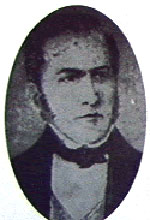
Manuel José Jimenes González was one of the leaders of the Dominican War of Independence. He served as the 2nd President of the Dominican Republic from September 8, 1848, until May 29, 1849. Prior to that he served as the country's Minister of War and Marine Affairs.

Ramón Báez Machado was a physician and politician from the Dominican Republic. He served as provisional president of the Dominican Republic from 28 August until 5 December 1914. He served as the President of Chamber of Deputies of the Dominican Republic in 1903. He was the son of president Buenaventura Báez. He later served as a public official under several cabinets including the government of President Horacio Vásquez.
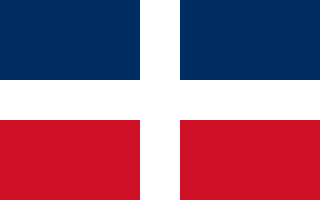
La Trinitaria was a secret society founded in 1838 in what today is known as Arzobispo Nouel Street, across from the "Del Carmen's Church" in the then occupied Santo Domingo, the current capital of the Dominican Republic. The founder, Juan Pablo Duarte, and a group of like minded young people, led the struggle to establish the Dominican Republic as a free, sovereign, and independent nation in the 19th century. Their main goal was to protect their newly liberated country from all foreign invasion. They helped bring about the end of the Haitian occupation of Santo Domingo from 1822 to 1844.

La Puerta del Conde was the main entrance to the fortified city of Santo Domingo, named to honor Governor Captain-General Bernardino de Meneses Bracamonte y Zapata, 1st Count of Peñalva, who during his tenure saved the city from a siege in 1655 by Englishmen General Robert Venables and Admiral William Penn amid the Third Anglo-Spanish War.
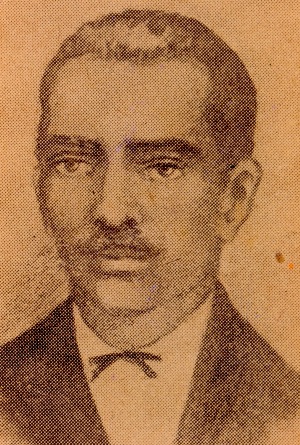
José Joaquín Puello de Castro was a Dominican revolutionary and military general who served as government minister in the Dominican Republic. He and his brothers, Gabino and Eusebio, were some of the prominent black leaders in the Dominican War of Independence. He stood out as a strategist in the wars of independence. He contributed to the plans of the Trinitarios, managing to integrate other figures such as Juan Erazo, Juan Alejandro Acosta and others into the fight who later stood out in patriotic interest.

Tomás Bobadilla y Briones was a writer, intellectual and politician from the Dominican Republic. The first ruler of the Dominican Republic, he had a significant participation in the movement for Dominican independence.

































